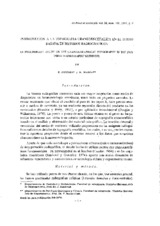Introduccion a la topografía craneoencefálica en el perro basada en metodos radiográficos
A preliminary study on the cranioencephalic topography in the dog using radiographic methods
Autor
Massa, R.
Agüera Carmona, Eduardo
Editor
Universidad de Córdoba, Servicio de PublicacionesFecha
1977Materia
PerrosCraneoencéfalo
METS:
Mostrar el registro METSPREMIS:
Mostrar el registro PREMISMetadatos
Mostrar el registro completo del ítemResumen
Radiographes of the cephalic region of German Sepherd dogs, obtained in normal circumstances, or contrasted, prior cisternal and ventricular repletion of "uroangiographin" on anesthetised animals. were used for a cranioencephalic topographi study. The Fundamental basilar and vertical axes for the coordinates were drawn un the photographic reproductions for this purpose, and also the most significant details of the encephalic (ventricle) configuratioh in relation tu these axes and skull structures which could serve as projection references. In the lateral views, the facial axis is drawn in the same way with the object of evaluations the cranio facial anglo of the breed studied. The radiographical interpretations were compared post-morten, not only with the obtainment of new "radiographical material (after cisternal and ventricular repletion "ad hoc"), but also by direct examination of midsagital cephalic sections and extraction of the herniencephali. Although in the radiographical image the cisternal and ventricular contrast is superimposed with the caracteristic radiopacity of certain parts of the neurocranium in general the procedure offers suficient data to illustre craniencephalic topography and proyection. Radiografías de la región cefálica de perros pastor alemán, obtenidas en circunstancias normales o contrastadas previa repleción cisterna! y ventricular de "Uroangiografin" en animales anestesiados, Se destinan a estudio de topografía craneoencefálica. A este fin, sobre reproducciones fotográficas de las radiografías se diseñan los ejes basilar y vertical fundamentales de coordenadas y se analizan los detalles más significativos de configuración encefálica (ventrículos) en relación con dichos ejes y con estructuras del cráneo que pueden servir como referencias de proyección; en las imágeneslaterales se diseña de igual modo el eje facial con objeto de valorar el ángulo craneofacial en la raza canina objeto de estudio. Las interpretaciones radiográficas se comprobaron post-mortem, no solamente con la obtención de nuevo material radiográfico (tras repleciones cisternales y ventriculares "adhoc"), sino también mediante examen directo en secciones cefálicas mediosagitales y extracción de los hemiencéfalos. Aunque en la imagen radiográfica el contraste cisternal y ventricular se superpone con la radiopacidad propia de ciertas partes del neurocráneo, el procedimiento brinda, en general, datos suficientes para ilustrar sobre la topografía y proyección craneoencefálica.

